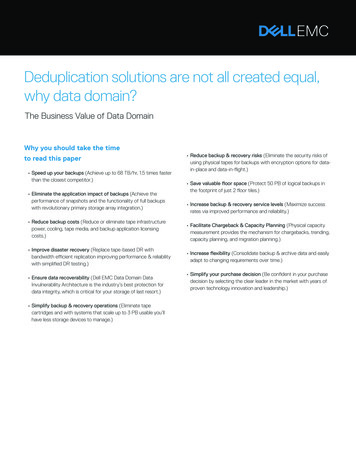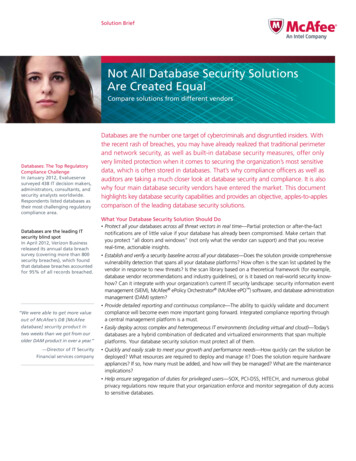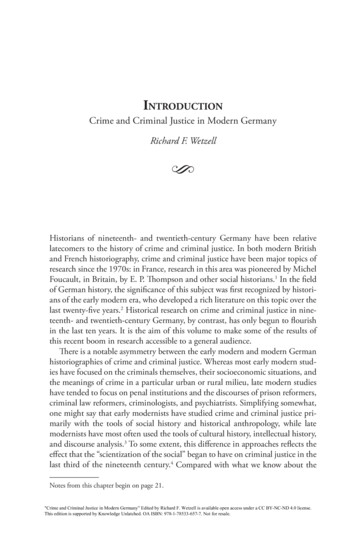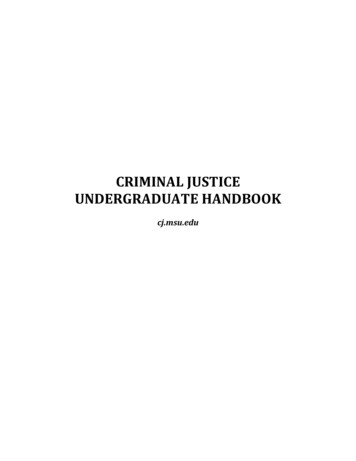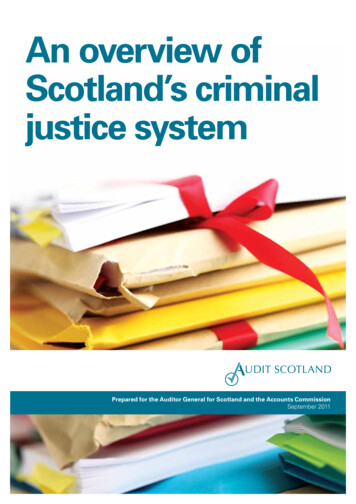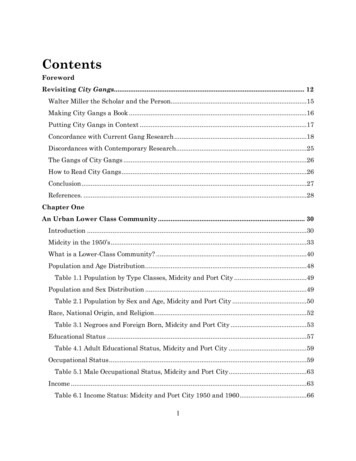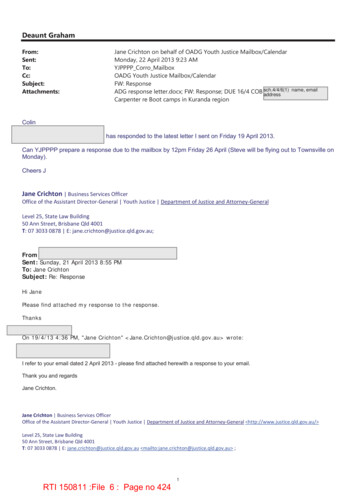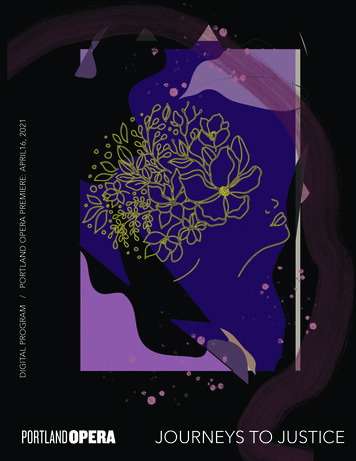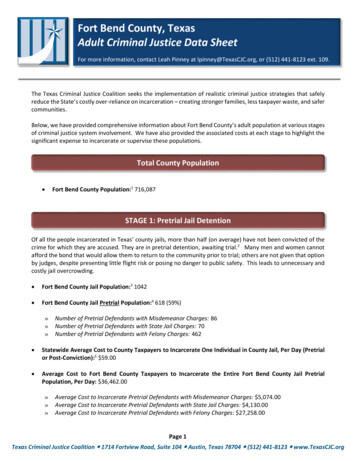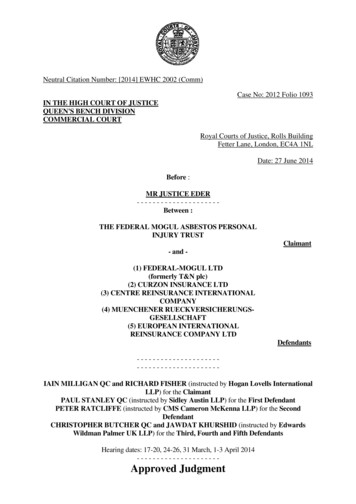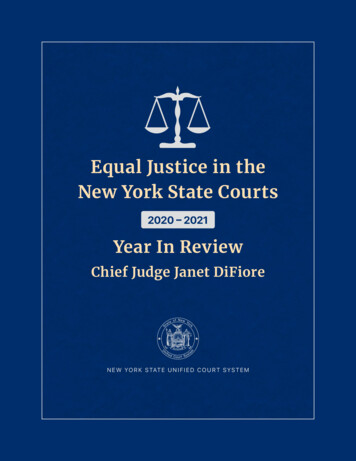
Transcription
Equal Justice in theNew York State Courts2020 – 2021Year In ReviewChief Judge Janet DiFioreN E W YO R K S TAT E U N I F I E D C O U RT SYS T E M
Equal Justice In The New York State Courts2020–2021 Year in ReviewChief Judge Janet DiFioreFOREWORD. . . . . . . . . . . . . . . . . . . . . . . . . . . . . . . . . . . . . . . . . . . . . . . . . . . . . . . . . . . . . . . . . . . . . . . . . . . . . . . . . . . . . . . . . . . . . . . . . . . . . . . . . . . . . . . . . . . . . . . . . . . . . . . . . 1INTRODUCTION. . . . . . . . . . . . . . . . . . . . . . . . . . . . . . . . . . . . . . . . . . . . . . . . . . . . . . . . . . . . . . . . . . . . . . . . . . . . . . . . . . . . . . . . . . . . . . . . . . . . . . . . . . . . . . . . . . . . . . . . . . . 31. UCS POLICY INITIATIVES: IMPLEMENTING ZERO TOLERANCE. . . . . . . . . . . . . . . . . . . . . . . . . . . . . . . . . . . . . . . . . . . . . . . . . . . 5 Leading From the Top: The Courts’ Commitment to Equal Justice. . . . . . . . . . . . . . . . . . . . . . . . . . . . . . . . . . . . . . . . . 5 A New Mission Statement. . . . . . . . . . . . . . . . . . . . . . . . . . . . . . . . . . . . . . . . . . . . . . . . . . . . . . . . . . . . . . . . . . . . . . . . . . . . . . . . . . . . . . . . . . . . . . . . . . 6 Social Media. . . . . . . . . . . . . . . . . . . . . . . . . . . . . . . . . . . . . . . . . . . . . . . . . . . . . . . . . . . . . . . . . . . . . . . . . . . . . . . . . . . . . . . . . . . . . . . . . . . . . . . . . . . . . . . . . . . . . . 6 Full Disciplinary Hearings Required for Substantiated Claims of Discrimination. . . . . . . . . . . . . . . . . . . . . . 6 Anti-retaliation Policy. . . . . . . . . . . . . . . . . . . . . . . . . . . . . . . . . . . . . . . . . . . . . . . . . . . . . . . . . . . . . . . . . . . . . . . . . . . . . . . . . . . . . . . . . . . . . . . . . . . . . . . . 7 Local Equal Justice Committees. . . . . . . . . . . . . . . . . . . . . . . . . . . . . . . . . . . . . . . . . . . . . . . . . . . . . . . . . . . . . . . . . . . . . . . . . . . . . . . . . . . . . . . . . . 7 Diversity in UCS Committees and Commissions. . . . . . . . . . . . . . . . . . . . . . . . . . . . . . . . . . . . . . . . . . . . . . . . . . . . . . . . . . . . . . . . . . . . 8 Review of All Legislative and Regulatory Proposals for Disparate Impact. . . . . . . . . . . . . . . . . . . . . . . . . . . . . 112. RACIAL JUSTICE IS AN ACCESS TO JUSTICE ISSUE. . . . . . . . . . . . . . . . . . . . . . . . . . . . . . . . . . . . . . . . . . . . . . . . . . . . . . . . . . . . . . . . . . . 12 Virtual Access and Bridging the Digital Divide. . . . . . . . . . . . . . . . . . . . . . . . . . . . . . . . . . . . . . . . . . . . . . . . . . . . . . . . . . . . . . . . . . . 12 Court Simplification to Promote Efficiency and Relieve Over-Burdened Courts. . . . . . . . . . . . . . . . . . . . 133. MANDATORY BIAS EDUCATION AND TRAINING. . . . . . . . . . . . . . . . . . . . . . . . . . . . . . . . . . . . . . . . . . . . . . . . . . . . . . . . . . . . . . . . . . . . 13 Comprehensive Mandatory Bias Training for Judicial and Non-Judicial Staff. . . . . . . . . . . . . . . . . . . . . . . . 14 Nuanced Bias Training for Judges. . . . . . . . . . . . . . . . . . . . . . . . . . . . . . . . . . . . . . . . . . . . . . . . . . . . . . . . . . . . . . . . . . . . . . . . . . . . . . . . . . . . . 15 Updated Trainings for Court Officers. . . . . . . . . . . . . . . . . . . . . . . . . . . . . . . . . . . . . . . . . . . . . . . . . . . . . . . . . . . . . . . . . . . . . . . . . . . . . . . . 16 Centralized Training for Town & Village Courts. . . . . . . . . . . . . . . . . . . . . . . . . . . . . . . . . . . . . . . . . . . . . . . . . . . . . . . . . . . . . . . . . . 16 Centralized Bias Training for UCS Non-Judicial Staff. . . . . . . . . . . . . . . . . . . . . . . . . . . . . . . . . . . . . . . . . . . . . . . . . . . . . . . . . . . 164. BUILDING ON EXISTING INSTITUTIONS. . . . . . . . . . . . . . . . . . . . . . . . . . . . . . . . . . . . . . . . . . . . . . . . . . . . . . . . . . . . . . . . . . . . . . . . . . . . . . . . . 17 The Office of Diversity and Inclusion. . . . . . . . . . . . . . . . . . . . . . . . . . . . . . . . . . . . . . . . . . . . . . . . . . . . . . . . . . . . . . . . . . . . . . . . . . . . . . . . . 17 The Franklin H. Williams Judicial Commission. . . . . . . . . . . . . . . . . . . . . . . . . . . . . . . . . . . . . . . . . . . . . . . . . . . . . . . . . . . . . . . . . . . . . 19 The Inspector General’s Office. . . . . . . . . . . . . . . . . . . . . . . . . . . . . . . . . . . . . . . . . . . . . . . . . . . . . . . . . . . . . . . . . . . . . . . . . . . . . . . . . . . . . . . . . . 215. COURT INITIATIVES ADDRESSING POTENTIAL JUROR BIAS AND RECRUITINGREPRESENTATIVE JURIES. . . . . . . . . . . . . . . . . . . . . . . . . . . . . . . . . . . . . . . . . . . . . . . . . . . . . . . . . . . . . . . . . . . . . . . . . . . . . . . . . . . . . . . . . . . . . . . . . . . . . . 23 New Juror Orientation Video. . . . . . . . . . . . . . . . . . . . . . . . . . . . . . . . . . . . . . . . . . . . . . . . . . . . . . . . . . . . . . . . . . . . . . . . . . . . . . . . . . . . . . . . . . . 23 Pattern Jury Instructions and Uniform Rules For Voir Dire. . . . . . . . . . . . . . . . . . . . . . . . . . . . . . . . . . . . . . . . . . . . . . . . . . 24 Jury Support Office Data, Training and Outreach Initiatives. . . . . . . . . . . . . . . . . . . . . . . . . . . . . . . . . . . . . . . . . . . . . . . 246. INCREASING DATA TRANSPARENCY AND AVAILABILITY. . . . . . . . . . . . . . . . . . . . . . . . . . . . . . . . . . . . . . . . . . . . . . . . . . . . . . . . 26 Court Data Page. . . . . . . . . . . . . . . . . . . . . . . . . . . . . . . . . . . . . . . . . . . . . . . . . . . . . . . . . . . . . . . . . . . . . . . . . . . . . . . . . . . . . . . . . . . . . . . . . . . . . . . . . . . . . . 26 Ensuring the Accuracy and Completeness of Court Data: The Adoption of UCMS. . . . . . . . . . . . . . . . . 27
7.ENHANCING LANGUAGE ACCESS. . . . . . . . . . . . . . . . . . . . . . . . . . . . . . . . . . . . . . . . . . . . . . . . . . . . . . . . . . . . . . . . . . . . . . . . . . . . . . . . . . . . . . . . . . 29 Interpretation and Translation Services. . . . . . . . . . . . . . . . . . . . . . . . . . . . . . . . . . . . . . . . . . . . . . . . . . . . . . . . . . . . . . . . . . . . . . . . . . . . . 298. DIVERSITY AND INCLUSION IN RECRUITING AND HIRING. . . . . . . . . . . . . . . . . . . . . . . . . . . . . . . . . . . . . . . . . . . . . . . . . . . . . . . 31 Interviews and Exams. . . . . . . . . . . . . . . . . . . . . . . . . . . . . . . . . . . . . . . . . . . . . . . . . . . . . . . . . . . . . . . . . . . . . . . . . . . . . . . . . . . . . . . . . . . . . . . . . . . . . . 339. FOSTERING TRUST BETWEEN COURT OFFICERS AND THE COMMUNITY. . . . . . . . . . . . . . . . . . . . . . . . . . . . . . . . . . 34 Enhanced Training. . . . . . . . . . . . . . . . . . . . . . . . . . . . . . . . . . . . . . . . . . . . . . . . . . . . . . . . . . . . . . . . . . . . . . . . . . . . . . . . . . . . . . . . . . . . . . . . . . . . . . . . . . . 34 Training Leaders. . . . . . . . . . . . . . . . . . . . . . . . . . . . . . . . . . . . . . . . . . . . . . . . . . . . . . . . . . . . . . . . . . . . . . . . . . . . . . . . . . . . . . . . . . . . . . . . . . . . . . . . . . . . . . 34 New Court Officer Manual. . . . . . . . . . . . . . . . . . . . . . . . . . . . . . . . . . . . . . . . . . . . . . . . . . . . . . . . . . . . . . . . . . . . . . . . . . . . . . . . . . . . . . . . . . . . . . . 35 Nametags. . . . . . . . . . . . . . . . . . . . . . . . . . . . . . . . . . . . . . . . . . . . . . . . . . . . . . . . . . . . . . . . . . . . . . . . . . . . . . . . . . . . . . . . . . . . . . . . . . . . . . . . . . . . . . . . . . . . . . . 35 Community Affairs Program. . . . . . . . . . . . . . . . . . . . . . . . . . . . . . . . . . . . . . . . . . . . . . . . . . . . . . . . . . . . . . . . . . . . . . . . . . . . . . . . . . . . . . . . . . . . . 35 Outreach Events. . . . . . . . . . . . . . . . . . . . . . . . . . . . . . . . . . . . . . . . . . . . . . . . . . . . . . . . . . . . . . . . . . . . . . . . . . . . . . . . . . . . . . . . . . . . . . . . . . . . . . . . . . . . . . 3510. BUILDING ON THE UCS COURT NAVIGATOR PROGRAM. . . . . . . . . . . . . . . . . . . . . . . . . . . . . . . . . . . . . . . . . . . . . . . . . . . . . . . . . . 36 Initial Operation and Success. . . . . . . . . . . . . . . . . . . . . . . . . . . . . . . . . . . . . . . . . . . . . . . . . . . . . . . . . . . . . . . . . . . . . . . . . . . . . . . . . . . . . . . . . . . . 36 Virtual Court Navigator Program. . . . . . . . . . . . . . . . . . . . . . . . . . . . . . . . . . . . . . . . . . . . . . . . . . . . . . . . . . . . . . . . . . . . . . . . . . . . . . . . . . . . . . 36 The Commission to Reimagine the Future of New York’s Courts and a Modernized CourtNavigator Program. . . . . . . . . . . . . . . . . . . . . . . . . . . . . . . . . . . . . . . . . . . . . . . . . . . . . . . . . . . . . . . . . . . . . . . . . . . . . . . . . . . . . . . . . . . . . . . . . . . . . . . . . . 37A SUSTAINED COMMITMENT TO RACIAL EQUITY. . . . . . . . . . . . . . . . . . . . . . . . . . . . . . . . . . . . . . . . . . . . . . . . . . . . . . . . . . . . . . . . . . . . . . . . 38APPENDICES. . . . . . . . . . . . . . . . . . . . . . . . . . . . . . . . . . . . . . . . . . . . . . . . . . . . . . . . . . . . . . . . . . . . . . . . . . . . . . . . . . . . . . . . . . . . . . . . . . . . . . . . . . . . . . . . . . . . . . . . . . . . . . 39 Appendix A: Further Addressing Bias in the Court System. . . . . . . . . . . . . . . . . . . . . . . . . . . . . . . . . . . . . . . . . . . . . . . . . . 39 Appendix B: Local Equal Justice Committees. . . . . . . . . . . . . . . . . . . . . . . . . . . . . . . . . . . . . . . . . . . . . . . . . . . . . . . . . . . . . . . . . . . . . . 42 Appendix C: Administrative Order Amending Rule 17.3 of the Rules of the Chief Judge. . . . . . . 48 Appendix D: Franklin H. Williams Commission Strategic Plan Summary Highlights andTimeline. . . . . . . . . . . . . . . . . . . . . . . . . . . . . . . . . . . . . . . . . . . . . . . . . . . . . . . . . . . . . . . . . . . . . . . . . . . . . . . . . . . . . . . . . . . . . . . . . . . . . . . . . . . . . . . . . . . . . . . . . . 50 Appendix E: Court Data Page Search Example. . . . . . . . . . . . . . . . . . . . . . . . . . . . . . . . . . . . . . . . . . . . . . . . . . . . . . . . . . . . . . . . . . . 53
FOREWORDLike millions of our fellow Americans, I was deeply shaken by the killing of George Floyd at thehands of the Minneapolis police on May 25, 2020. As I contemplated an appropriate response inmy capacity as Chief Judge and leader of the branch of government charged with providing equaljustice under law, I felt strongly that simply making a public statement of condemnation wouldbe inadequate and that the moment called for meaningful and concrete action. Ironically, beforeI could even announce a response, our court family was again shaken, this time by a vile and racistFacebook posting made by one of our Court Officer employees. This development confirmed mydecision: it was time to move forcefully to take ownership of our obligation to confront and eliminate any and all forms of racism and bias in the New York State Courts.On June 9, 2020, I announced that Jeh Johnson, a nationally respected lawyer and former UnitedStates Secretary of Homeland Security, had agreed to my request to lead a thorough, independent, no-holds-barred “Equal Justice Review” of the New York State Unified Court System’s policies and practices as they relate to issues of racism, bias and disparate treatment. I asked SecretaryJohnson to evaluate everything we do, from how we investigate claims of discrimination to howwe train and educate our judges and court staff on bias issues, to how we go about appointingand promoting judicial and nonjudicial officers and employees.Secretary Johnson and his team conducted a rigorous four-month study of our court system, interviewing hundreds of individuals and organizations about their experiences in the New York Statecourts. In October 2020, Secretary Johnson issued a timely and comprehensive “Report on EqualJustice in the Courts,” which commended New York’s judges and court professionals for their dedication and commitment to equal justice. The Equal Justice Report also identified various problemsin need of our attention and reform, including the treatment of litigants of color in our under-resourced and overburdened high-volume courts; frequent instances of racial intolerance within ourcourt family; and the need to strengthen and reaffirm our commitment to diversity and meaningful inclusion within our judicial and nonjudicial ranks.Chief Administrative Judge Lawrence Marks and I fully embraced Secretary Johnson’s findings anddetermined to do better – much better – to address the shortcomings identified in the report. TheEqual Justice Report contained an excellent set of practical recommendations to guide our reformefforts, and we have pledged to faithfully implement all of them, starting with the first and mostimportant recommendation: our commitment on behalf of the entire New York State UnifiedCourt System to a policy of “zero tolerance” for racial bias and discrimination. During the 2021State of Our Judiciary Address that I delivered to our partners in government and all New Yorkers,I expressed my “solemn, unshakeable commitment to achieve a policy of zero tolerance for racialbias and discrimination for as long as I have the privilege of serving as Chief Judge.”Recognizing that our commitment to equal justice will be measured not by the eloquence of ourwords but by our actions and ability to get things done, we appointed and empowered Hon.Edwina Mendelson, Deputy Chief Administrative Judge For Justice Initiatives, to lead our day-today efforts to implement the Equal Justice recommendations. Chief Administrative Judge Marksand Judge Mendelson convened an Implementation Committee of judicial leaders and managerswhich met with judges, court staff and representatives of fraternal organizations, affinity groups,bar associations and stakeholders to develop a detailed and effective strategic plan to guide ourinstitutional efforts to implement short- and long-term equal justice reform.Equal Justice in The New York State Courts: 2021 Year In Review1
As this “Year in Review Report” surely demonstrates, an enormous amount of progress has alreadybeen accomplished to begin the transformation of our court system into a model of fairness,equity and inclusion in everything we do. In just one year, under Judge Mendelson’s day-to-dayleadership, and with the benefit of the input and active participation of our court family, we havepursued implementation in a thorough, thoughtful, open and transparent manner, including: Adopting policy changes to specifically support our zero tolerance policy; Creating and supporting initiatives to expand access to justice and court services in courtsthat serve low-income communities and people of color; Mandating comprehensive education and training to address critical issues such as implicitbias; and Initiatives to strengthen existing court-based institutions and enable them to better carryout their respective missions of combating bias and discrimination and promoting equityand inclusion.In addition to the dozens of statewide initiatives and reforms described in this Report, I amproud of the efforts that are underway at the local court level to change our institutional culturefrom the bottom up. Our Administrative Judges, Supervising Judges and Court Managers haveled the way in their respective jurisdictions, engaging judges and court staff in the work thatneeds to be done to make good on our obligation to treat everyone we work with, and everyonewho appears before us, with the utmost fairness and equity.Over the last year, we have made it our highest institutional priority to fully implement SecretaryJohnson’s Equal Justice recommendations, and our judges and staff across the state and at everylevel of our court system have rededicated themselves to combatting racism and bias and maintaining public trust and confidence in our ability to ensure equal justice for all.I am grateful to Judge Mendelson for her strong leadership of our Equal Justice in the CourtsInitiative, and for preparing this Year in Review Report to mark our progress and catalogue thework that has been done. Importantly, that work cannot and will not cease when the EqualJustice recommendations are all implemented. Our commitment to equal justice must be anongoing, open-ended process in which we continuously strive to achieve the highest standardsof fairness, equality and meaningful inclusion within our court system.I want to acknowledge and thank our Independent Monitor, Hon. Carmen Beauchamp Ciparick(retired Senior Associate Judge of the Court of Appeals), for carefully reviewing and evaluatingour ongoing efforts and future plans. She will make certain that we follow through faithfully onour Equal Justice commitments. And I want to thank Alphonso David for his valued past servicein this capacity.Finally, I want to express my heartfelt thanks and appreciation to the judges and professionalstaff of the New York State Unified Court System. The courts, above all institutions, have a solemn obligation to ensure that every person who appears before us, and every colleague wework with, is treated with equal justice, dignity and respect. As demonstrated in this Report, ourjudges and staff have answered the call to equal justice and are leading by example.Janet DiFioreChief Judge of the Court of Appeals andthe State of New York2Equal Justice in The New York State Courts: 2021 Year In Review
INTRODUCTION“The death of George Floyd, and the issues it has brought into harsh focus, are a painful reminder of the repeated injustices and institutional racism that have long undermined the values and unity of our nation. The court system’s commitment to these valuesis especially vital. Their preservation is a cornerstone of the rule of law, the subject ofsacred oaths taken by all judges and lawyers, and the daily endeavors of the thousandsof court employees around the State who work tirelessly to advance the cause of justice.”– Chief Judge Janet DiFiore, June 9, 2020In June 2020, amid a global pandemic, our nation was confronted once again with the painfulimpact and long-standing consequences of racism, bias, and inequality. The horrific and internationally broadcast murder of George Floyd highlighted the urgency of addressing these structuralinequalities, as they continue to pervade our most fundamental institutions. The courts are noexception. Within our own walls — among our own court family — virulently racist words andimages were posted on Facebook during 2020. Unfortunately, this was not an isolated incident.There have been other equally troubling racially charged events within our courts.Recognizing the weight of this historic moment and the opportunity it presented, Chief JudgeJanet DiFiore commissioned former presidential cabinet member Jeh Johnson to assist the courtsin addressing issues of institutional racism by reviewing the New York State Unified Court System’s(“UCS”) policies, practices, rules and programs as they relate to issues of racial or other bias. SecretaryJohnson and his team performed a rigorous and independent assessment of our court system. Theyconducted 96 interviews with 289 individuals, including current and former judges and court stafffrom nearly every type of court, public and private law practitioners, bar, judicial and civic associations, and other community stakeholders. Secretary Johnson’s team also reviewed numerous submissions from the public, assessed past reports and ongoing work addressing racial bias in the courts,and examined UCS policies and practices on hiring, promotion, workplace conduct and bias training.The Special Adviser’s Report on Equal Justice in the Courts (“Special Adviser’s Report”) was issuedon October 1, 2020. The good news, according to the Special Adviser’s Report, was the intensepride and dedication court employees feel for their work. The report acknowledged that judgesand staff alike, throughout the state, all work hard to get it right and make it better. The “badnews,” however, was that multiple interviewees from all perspectives described an “under-resourced, over-burdened” New York State court system, the “dehumanizing effect” the systemhas on litigants, and the “disparate impact all this has on people of color.” Equally striking, “overand over” again, Johnson’s team heard about the “dehumanizing” and “demeaning cattle-callculture” in our highest-volume courts. “The sad picture that emerged is in effect, a second-classsystem of justice for people of color in New York State.”1Moreover, as noted in the Special Adviser’s Report, these issues are not new. A 1991 report written by the Minorities Commission (now known as the Franklin H. Williams Judicial Commission[Williams Commission]) declared that “there are two justice systems at work in the courts ofNew York State, one for Whites, and a very different one for minorities and the poor.” Thirtyyears later, with the objective of setting clear and achievable goals, the Special Adviser’s Reportset forth thirteen “specific, practical and workable” recommendations centered on operationalissues within the court’s power to implement “administratively and unilaterally.”21.2.Special Adviser’s Report at pp. 2-3, 54.Special Adviser’s Report p. 3-4Equal Justice in The New York State Courts: 2021 Year In Review3
In the past year, the court system has absorbed both the gravity and breadth of the Special Adviser’s Report. Court leaders at the highest levels have embraced the urgency of addressing not onlythe Special Adviser’s practical recommendations, but also his observations of a “second-class” justice system for people of color. Immediately following the report’s publication, Chief Judge DiFioreand Chief Administrative Judge (CAJ) Lawrence Marks appointed Edwina G. Mendelson, DeputyChief Administrative Judge (DCAJ) For Justice Initiatives, to lead UCS’s implementation efforts.Together, CAJ Marks and DCAJ Mendelson established an Implementation Committee comprisedof court administrative leaders and judges. Judge Mendelson, who also leads the court’s Office forJustice Initiatives, has since participated in convenings with UCS leadership, bar associations, institutional providers, fraternal organizations, and other affinity groups and stakeholders, to developa strategic plan for implementing the Special Adviser’s recommendations.Addressing these critical issues has been a significant undertaking for a branch of governmentwith thousands of judges and employees who perform a vast array of different functions. Duringthe past year, UCS has developed a number of policy and programmatic initiatives that include: Amendment of Section 17.3 of the Rules of the Chief Judge to require that all state-paid3judges receive regular anti-bias trainings; Mandatory bias education and training for all UCS non-judicial personnel; Mandatory bias education and training for Town and Village judges and non-judicial personnel; A suite of publicly available technological tools, with demographic data for the judiciary,for the UCS work force, and for defendants in criminal matters; Expanded diversity initiatives, including the development of extensive educational materials on interviewing, civil service examinations and the hiring process, and revamped interview process – all available on the UCS public website; Appointment of an ombudsperson for bias matters and widely publicized and clarifiedcomplaint procedures for bias matters; Establishment of an annual Diversity Summit to promote diversity in the court system andto address matters of concern to the court community expressly related to issues of equityand inclusion; Participation in Town Hall meetings sponsored by the Williams Commission to address matters of concern to the court community expressly related to issues of racial bias; Creation of local Equal Justice Committees in each of New York’s thirteen judicial districts; Development of a new juror orientation video, Jury Service and Fairness, to educate potential jurors and grand jurors about the dangers of implicit bias; and Implementation of new policies and protocols expressly designed for court officers andother uniformed personnel, such as specialized implicit bias training, the requirement ofnametags, and a designated Community Affairs Officer to be assigned in every courthouse.While this annual report reflects our initial accomplishments, understanding and addressing racialbias is – and must be understood as – a continuous process. There is no “one and done” solution,there is no quick fix. This process, in which every member of the UCS community has been invitedto participate, will continue to guide the courts’ responses to the recommendations in the SpecialAdviser’s Report. To improve the court experience for people of color, including court users, theUCS workforce, our judges and stakeholders, UCS is — at every level — thoroughly evaluatingcourt institutions and procedures. With the Special Adviser’s Report as our starting point, we striveto operate a justice system that is equally accessible and meaningful for all.3.4“State-paid judges” are judges paid directly by the Office of Court Administration. Town and Village judges are paidindependently by their local governments.Equal Justice in The New York State Courts: 2021 Year In Review
1. UCS POLICY INITIATIVES:IMPLEMENTING ZERO TOLERANCELEADING FROM THE TOP: THE COURTS’ COMMITMENTTO EQUAL JUSTICEDuring his review, the Special Adviser consistently heard from judges, attorneys, publicsafety officers and other non-judicial personnel that “‘change needs to come from the top’”.The report also highlighted that the court system had not articulated a “race and equityagenda” in any of its public reports or pronouncements and had not set explicit standards orgoals related to diversity and inclusion. Noting the successful culture shift arising from thedevelopment of institutional sexual harassment policies with a “zero tolerance” approach,the Special Adviser’s report recommended that the Office of Court Administration (OCA)adopt a “zero tolerance” policy for racial bias, “along with an expression that the duty touphold this policy extends to all those working within the New York state court system –from judges, interpreters to court officers.”4Chief Judge DiFiore has fully embraced a zero tolerance policy for bias and discriminationand has done so in the strongest terms:In order to function as intended, our justice system depends on the public’s trust andconfidence in our ability to carry out our mission of fair and equal justice for all. Andequally important, the people who make up our court system, and those who represent and lead our system, must inspire that very same confidence. As judges andcourt professionals, we have a solemn obligation to identify and eliminate racial biasfrom our courts.Secretary Johnson has advanced an excellent set of practical recommendations Andthe first and most important of his recommendations –that we make “a commitmentfrom the top” to embrace a policy of zero tolerance for racial discrimination – is onethat I fully embrace on behalf of our entire court leadership team across the state.We will honor that commitment, and we will honor our commitment to implementall of the recommendations laid out in the Special Adviser’s Report, from improvingthe way we train, educate, and sensitize judges and court staff on issues of implicitbias, to strengthening the enforcement of our discrimination policies to implementing clear policies and guidelines addressing social media. There can be no higherpriority for us as an institution than ensuring that every person is treated with equaljustice, dignity and respect.54.5.Special Adviser’s Report, p.79-80.Weekly Address of the Chief Judge, October 19, 2020. See also Weekly Addresses of the Chief Judge, December 21,2020, December 28, 2020, January 4, 2021, January 18, 2021; March 1, 2021, March 29, 2021, May 23, 2021, May 17,2021, June 7, 2021, August 9, 2021, and February 8, 2021.Equal Justice in The New York State Courts: 2021 Year In Review5
A NEW MISSION STATEMENTCourt system leadership has undertaken a series of accompanying policy initiatives intendedto implement the zero tolerance policy in specific ways. In a May 2021 press release, UCSpublicly announced its new mission statement, broadly affirming a commitment to transparency and a responsibility to promote a diverse and bias free court system.The mission of the Unified Court System (UCS) is to deliver equal justice under the law andto achieve the just, fair and timely resolution of all matters that come before our courts.In the service of our mission, the UCS is committed to operating with integrity and transparency, and to ensuring that all who enter or serve in our courts are treated with respect,dignity and professionalism. We affirm our responsibility to promote a court system freefrom any and all forms of bias and discrimination and to promote a judiciary and workforcethat reflect the rich diversity of New York State.6SOCIAL MEDIAThe Special Adviser reported that “[s]ocial media posts are a growing source of racial biascomplaints among court employees.”7 In light of several past and more recent offensive socialmedia posts, OCA has, in accordance with the Special
Johnson to evaluate everything we do, from how we investigate claims of discrimination to how . institutional efforts to implement short- and long-term equal justice reform. 2 Equal Justice in The New York State Courts: 2021 Year In Review . from nearly every type of court, public and pr
